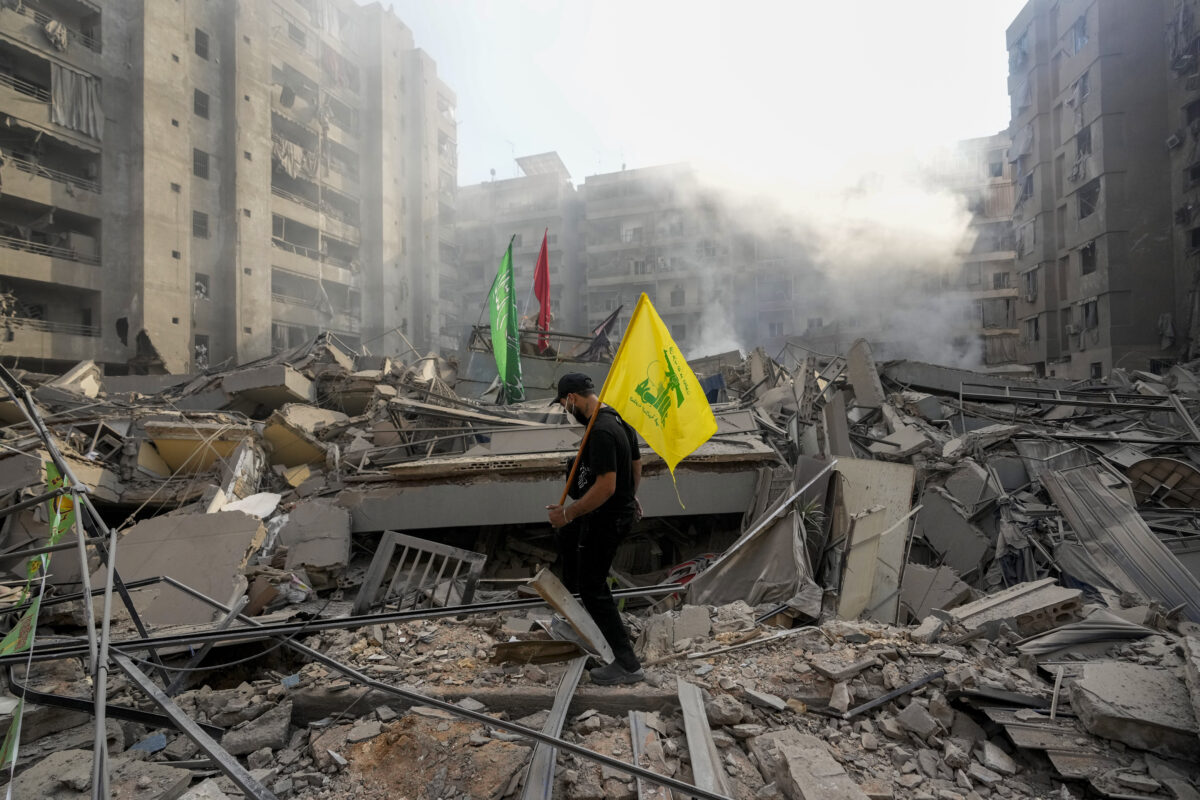
FILE – A man carries a Hezbollah flag as he walks on the rubble of his destroyed apartment following an Israeli airstrike in Lebanon, Nov. 1, 2024. —AP Photo/Hassan Ammar/File
BEIRUT, Lebanon — A severely hobbled Hezbollah was in no position to help defend former Syrian President Bashar Assad, a longtime ally, from the lightning-fast insurgency that toppled him. With Assad gone, the militant group based in Lebanon is even weaker.
Hezbollah was dealt a major blow during 14 months of war with Israel. The toppling of Assad, who had strong ties to Iran, has now crippled its ability to bounce back by cutting off a vital weapons-smuggling route through Syria.
Hezbollah officials are deeply concerned but defiant.
“What is happening in Syria is a major, dangerous and new change, and to know why this happened needs evaluation,” Hassan Fadlallah, a Lebanese lawmaker who represents Hezbollah’s political wing, said during a speech at a funeral for militants killed by Israel. “Whatever is happening in Syria, despite its dangers, will not weaken us.”
Analysts say the diminishment of Hezbollah will have big consequences for Lebanon, where for decades it has been a major political player — and for Iran, which has relied on the group as one of several proxy forces projecting power across the Middle East. It is also a game-changer for Israel, whose nemesis on its northern border is now at its most vulnerable point in decades.
Ties to Syria
The Assad dynasty, which ruled Syria for half a century with an iron fist, played a crucial role in empowering Hezbollah, which was founded in the early 1980s by Iranian advisers who came through Syria. In addition to being a conduit for Iranian weapons, Syria also was a place where Hezbollah trained fighters and manufactured its own weapons.
As Hezbollah grew more powerful, it became a force Assad could rely on for protection in times of crisis. Hezbollah sent thousands of fighters to bolster Assad’s forces when a civil war broke out in 2011.
As insurgents swept across Syria in early December and took the city of Homs — a stone’s throw from a Syrian border town where Hezbollah had a presence — many expected the militants to put up a fierce fight. After all, they did just that in 2013, preventing Assad’s opponents from advancing into Damascus.
This time, Hezbollah was in disarray. Many of its top officials, including longtime leader Hassan Nasrallah, were killed in Israeli airstrikes. And months of Israeli bombardment destroyed much of its military infrastructure. With Syria’s key international allies, Russia and Iran, on the sidelines, Hezbollah withdrew, and Assad was ousted quickly.
“The fall of the regime marks the end of Iran’s arms in Syria and Lebanon,” said Lt. Col. Fares al-Bayoush, a Syrian army defector who fought in the civil war against Assad’s forces and Hezbollah until 2017, when he moved to Turkey.
Hezbollah’s ‘new reality’
In Lebanon, the sapping of Hezbollah’s strength has given the army the opportunity to reassert control it had ceded, especially along its southern border. A U.S.-brokered ceasefire between the militant group and Israel states that Hezbollah should have no armed presence along that border and it has led to growing calls within Lebanon for the group’s disarmament.
“To Hezbollah, it’s game over,” Samir Geagea, who leads the Christian Lebanese Forces Party, said in a statement on Sunday, hours after insurgents took Damascus. “Sit with the Lebanese military to end your status as an armed group, and transform yourselves into a political party.”
But Hezbollah’s longtime sway in the political arena in Lebanon also faces a major challenge.
Many in Lebanon are angry with the group. Critics say Hezbollah violated its promise to use its weapons only to defend Lebanon when it began firing rockets into Israel last year, the day after Hamas — another Iranian-backed group — attacked Israel.
Nearly 4,000 people were killed in Lebanon during the war with Israel, according to the country’s health ministry. Entire towns and villages where Hezbollah militants and their supporters lived have been flattened. More than 1 million people have been displaced, and the country’s economy — which was in bad shape before the war — is in a deep hole.
“With the (Syrian) regime gone, Hezbollah in Lebanon faces an entirely new reality,” said Firas Maksad, of the Middle East Institute.
Maksad said many Lebanese leaders have yet to grasp the magnitude of the change that has taken place. Even some onetime allies of Hezbollah in parliament have begun distancing themselves from the group.
Gebran Bassil, a lawmaker who represents the Free Patriotic Movement, Lebanon’s other major Christian party, said Hezbollah’s loss of a weapons pipeline from Iran could help Lebanon extract itself from regional conflict.
“Hezbollah should focus on internal affairs and not the wider region,” Bassil, a former ally of Hezbollah, said.
It may have no choice but to narrow its ambitions. With the fall of Assad, Iran has lost control of a corridor of land that stretched through Iraq and Syria all the way to the Mediterranean, and which gave it an unimpeded route to supply Hezbollah.
“They can maybe fly in some things and smuggle some things, but that’s not gonna be on the same scale, not even close,” said Aron Lund, a Syria expert with Century International, a New York-based think tank.
For Israel, breaking Iran’s regional network has been a major goal, though it is wary over Islamic militants among the insurgents who toppled Assad. Israel on Sunday moved troops into a demilitarized buffer zone with Syria by the Israel-held Golan Heights in what it called a temporary security measure.
Prime Minister Benjamin Netanyahu called Assad’s fall a “historic day,” saying it was “the direct result of our forceful action against Hezbollah and Iran, Assad’s main supporters.” —AP

